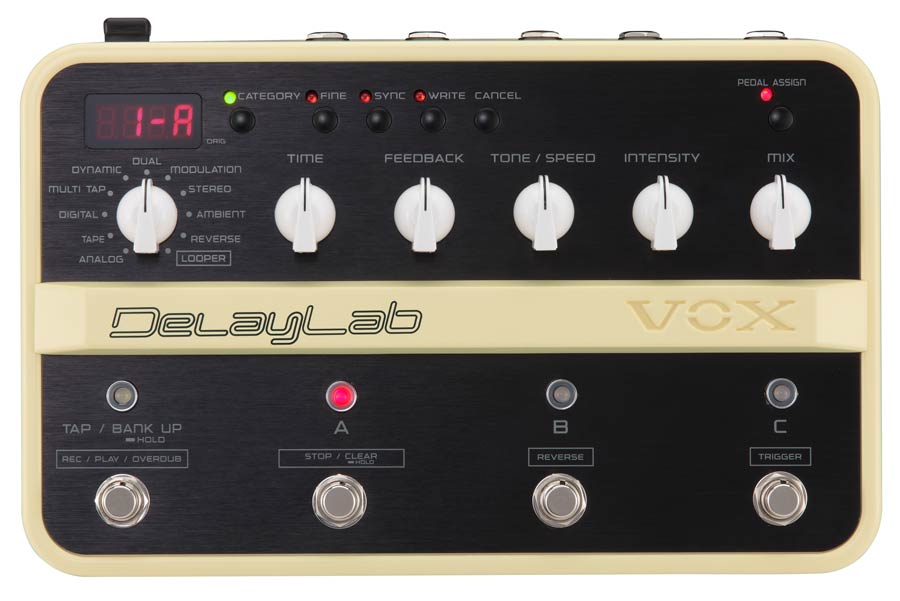
Vox has just unveiled their new DelayLab pedal, which aims to combine all the classic delay sounds and more into one handy pedal. In addition to 30 diverse delay effects, the DelayLab offers a stereo looper that can capture up to 28 seconds.
Check out the video below for a demo of all the DelayLab's capabilities, and head over to Vox's website for all the info on the DelayLab and other new products for 2012.
From Vox: Delay effects are a must for satisfying the individualistic creativity of any guitarist. Their long history encompasses both the analog and digital eras. Many classic delay units have played a prominent role through the years, contributing to numerous memorable phrases, generating dreamlike spaces, and producing psychedelic performances, both on stage and in the studio. These sought-after units – as well as new delays destined to become standards for the coming generation – are all included in the VOX DelayLab. In addition to 30 diverse delay effects, the DelayLab offers a stereo looper that can capture up to 28 seconds, 30 stage-ready programs, and a wealth of extras, all packed into a sturdy diecast body. With an expressly vintage vibe, the easy-to-use front panel offers satisfying hands-on control over a diverse array of sounds and features. In short, the DelayLab delivers virtually infinite potential, befitting its status as the new standard for effect processors.
Over the years, numerous delay effects have come along; tape echoes, analog delays, digital delays, etc. Each has varied by type, manufacturer, and internal structure. From the distinctive distortion and warmth of tape, the unique tonal change produced by an analog BBD (Bucket Brigade Device) circuit, to the lo-fi sound typical of low-resolution digital circuitry, the DelayLab delivers perfect models for a carefully selected set of historically significant delay units that have fascinated guitarists through the years. There are also numerous special types of effects such as pitch change, panning, and reverse. Parameters not found on the original models are also provided, offering unique expressive possibilities that go beyond simply modeling the classic units of the past.
The DelayLab also contains numerous practical and original delay effects that will inspire any guitarist. Dual Delay makes effective use of two delays; Distortion Delay adds distortion to only the delayed sound; Reverse Delay can adjust the mix ratio between forward and reverse sound; Space Delay applies a string-like tonal effect to deepen the sound. An incredible array of possibilities are available, as any of these effects are capable of creating aggressive and radical sounds, as well as being used to add a subtle sense of depth.
The DelayLab provides extensive looper capabilities that can be combined with the delay effects to surpass the abilities of the numerous dedicated units that have been in the spotlight of guitar performance in recent years. The DelayLab goes well beyond simply layering sounds by providing features that open up new creative possibilities – such as reverse playback, triggered playback, and using an expression pedal to control various parameters. There are also three types of delay that can be used simultaneously with the looper. Plus, the DelayLab is able to create performances overflowing with originality by adjusting the L/R delay times independently, or by attenuating the volume of the looped phrases each time you overdub so that the latest overdub will stand out.
The thirty preset programs take full advantage of the DelayLab's extensive features and parameters. Editable and re-writable, these programs range from simple and versatile types, to complex and distinctive effects. There are also programs that reproduce the delay sound of famous guitarists as heard on classic recordings.
Get The Pick Newsletter
All the latest guitar news, interviews, lessons, reviews, deals and more, direct to your inbox!
Josh Hart is a former web producer and staff writer for Guitar World and Guitar Aficionado magazines (2010–2012). He has since pursued writing fiction under various pseudonyms while exploring the technical underpinnings of journalism, now serving as a senior software engineer for The Seattle Times.
“Our answer to everything players have asked for and more”: Neural DSP’s Nano Cortex had one major drawback – but now it’s been addressed with a huge free firmware update that takes on Kemper and TONEX
"The ability to use this as a midweight MIDI brain for a gigging setup is what makes it unique.": Walrus Audio Canvas Clock review










